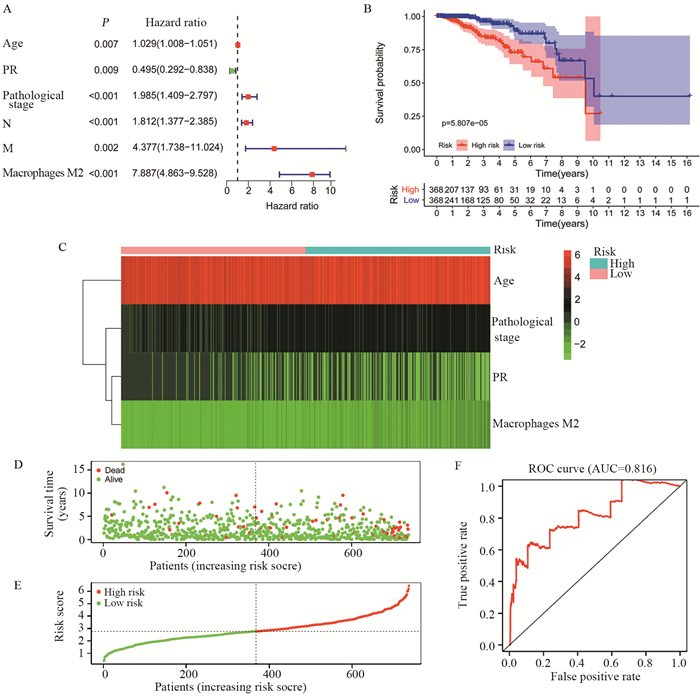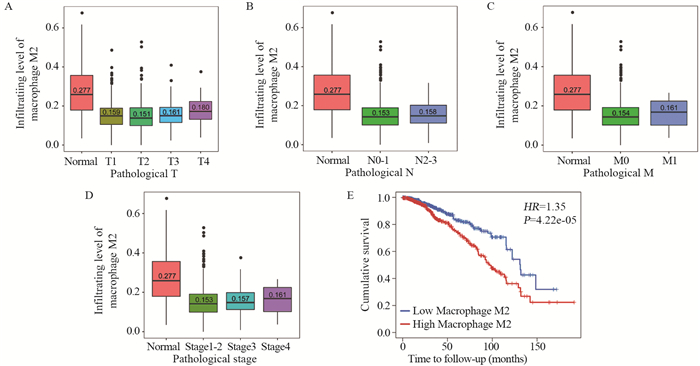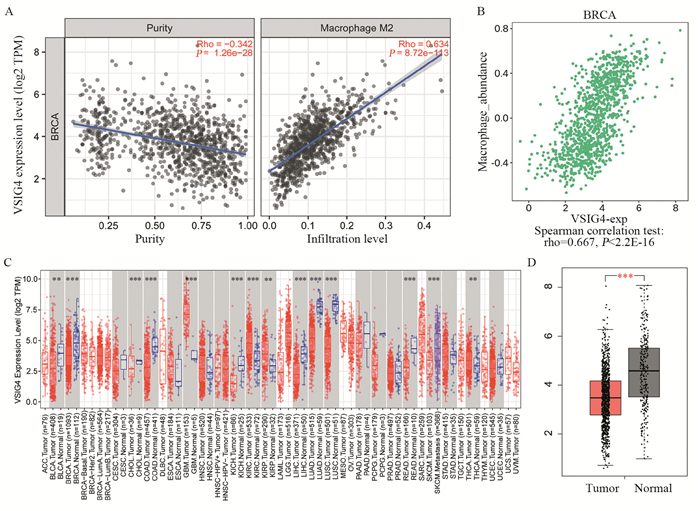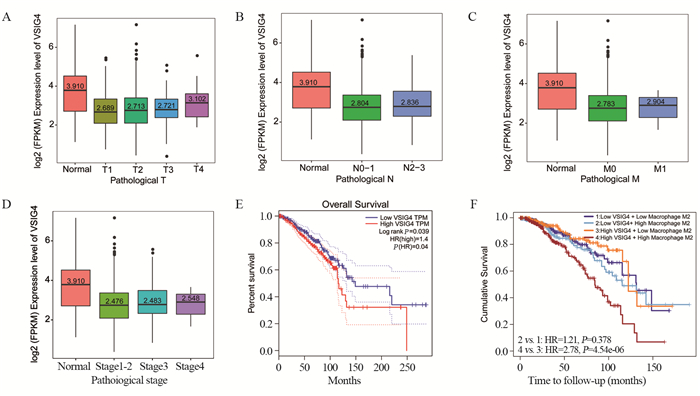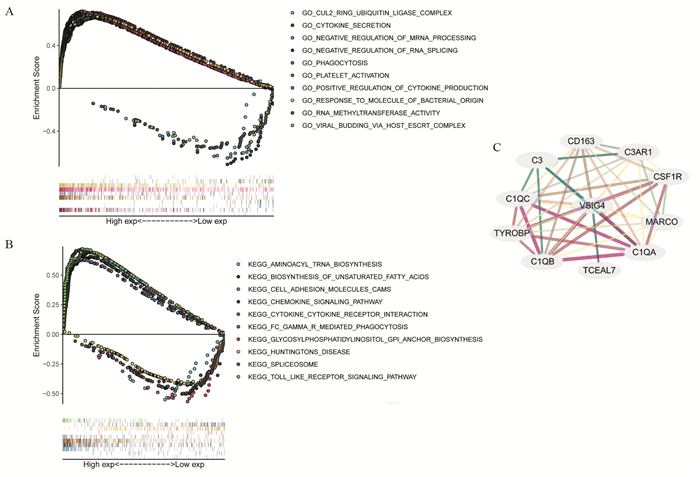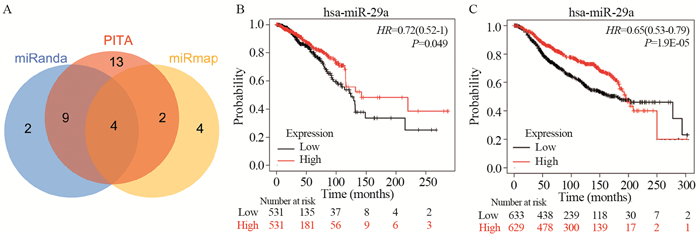Expression Level of VSIG4 in Breast Cancer and Its Correlation with Immune Infiltration and Prognosis
-
摘要:目的
分析M2型巨噬细胞在乳腺癌组织中的浸润丰度,探索VSIG4与M2型巨噬细胞的相关性及调控乳腺癌侵袭和迁移的潜在机制。
方法下载TCGA-BRCA的RNA-seq数据,CIBERSORT评估样本的免疫细胞浸润丰度,构建预后风险预测模型。分析M2型巨噬细胞及VSIG4对乳腺癌患者预后的影响,基因集富集分析VSIG4参与的信号通路,并预测其上游调控miRNA。
结果M2型巨噬细胞的浸润丰度与年龄、PR状态、病理分期共同参与构建风险预测模型,模型预测性能较好(AUC=0.816)。M2型巨噬细胞的高浸润(HR=1.35, P < 0.05)及VSIG4的高表达(HR=1.4, P=0.039)提示乳腺癌患者预后较差。VSIG4受上游miR-29a-3p调控,与Toll样受体、细胞黏附、细胞因子的生成及释放等通路显著相关。
结论VSIG4与乳腺癌患者预后及M2型巨噬细胞浸润丰度显著相关,受上游miR-29a-3p调控,VSIG4促进乳腺癌细胞的侵袭和迁移,可作为乳腺癌的潜在预后标志物。
Abstract:ObjectiveTo analyze the infiltration abundance of macrophage M2 in breast cancer tissues and explore the correlation between VSIG4 and macrophage M2 and the potential mechanism of regulating the invasion and migration of breast cancer patients.
MethodsWe downloaded the RNA-seq data of TCGA-BRCA and assessed the infiltration abundance of immune cells in the samples by CIBERSORT, and established a prognostic risk prediction model. Then, we analyzed the effect of macrophage M2 and VSIG4 on the prognosis of breast cancer patients. In addition, we analyzed the signaling pathway associated with VSIG4 by gene set enrichment analysis and predicted its upstream regulation of miRNA.
ResultsThe infiltration abundance of macrophage M2, age, PR status and pathological stage were involved in the establishment of risk prediction model, and the model had a good prediction performance (AUC=0.816). High infiltration of macrophage M2 (HR=1.35, P < 0.05) and high expression of VSIG4 (HR=1.4, P=0.039) suggested poor prognosis of breast cancer patients. VSIG4 could be regulated by upstream miR-29a-3p and significantly correlated with Toll-like receptor, cell adhesion, production and release of cytokine.
ConclusionVSIG4 is significantly associated with breast cancer patients' prognosis and infiltration of macrophage M2, regulated by the upstream miR-29a-3p and promotes the invasion and migration of breast cancer cells. It can be used as a potential prognostic marker for breast cancer.
-
Key words:
- VSIG4 /
- Macrophage M2 /
- Breast cancer /
- Prognostic model /
- Prognostic marker /
- Tumor infiltration immune cells
-
0 引言
乳腺癌(breast cancer, BC)是全世界最常见的恶性肿瘤之一,据预计,2020年美国的乳腺癌女性患者将占所有女性癌症患者的30%(276 480)和癌症死亡人数的15%(42 170)[1]。然而,仍然缺乏有用的乳腺癌免疫治疗生物标志物。因此,急需识别和转化乳腺癌新的免疫相关分子标志物和治疗靶点。
肿瘤与人体免疫系统之间的相互作用在肿瘤的发生发展和诊疗中起着至关重要的作用。肿瘤微环境(tumor microenvironment, TME)由肿瘤细胞及其周围基质和肿瘤浸润免疫细胞(tumor infiltrating immune cells, TIICs)组成[2]。研究表明高浸润丰度的肿瘤相关巨噬细胞(tumor-associated macrophages, TAM)与肿瘤的不良预后相关,大多数TAM表达为M2表型。关于机制研究,有研究表明TLR2/NOX2/自噬轴、Wnt/β-catenin信号通路等可以促进M2型巨噬细胞极化,增强肿瘤的恶性行为[3-4]。V-set包含免疫球蛋白域4(V-set and immunoglobulin domain containing 4, VSIG)是M2型巨噬细胞的免疫标记基因[5],并且,VSIG4表达水平与卵巢癌、肝细胞癌、前列腺癌、结直肠癌等多种癌症的预后相关[6-9],但关于VSIG4在乳腺癌中的研究目前仍较少。
本研究通过CIBERSORT(https://cibersort.stanford.edu/)计算乳腺癌样本中TIICs的浸润丰度,通过建立乳腺癌风险模型,从多方面分析M2型巨噬细胞与乳腺癌患者的预后相关性。并进一步通过基因集富集分析(gene set enrichment analysis, GSEA)分析VSIG4的表达水平与多种信号通路之间的相关性,并预测VSIG4的上游调控miRNA,探索VSIG4与乳腺癌肿瘤免疫之间的潜在机制。
1 资料与方法
1.1 患者数据获取
从TCGA下载乳腺癌患者的RNA-seq数据(经过FPKM标准化)和临床资料(包括年龄、生存时间、生存状态、T、N、M、病理分期、ER、PR、HER2状态),包括1 109例乳腺癌肿瘤标本和113例乳腺癌癌旁组织标本。
1.2 肿瘤免疫分析
基于RNA-Seq数据,利用“Cibersort”R包来估计单样本中22种免疫细胞的丰度。通过肿瘤免疫估计资源(tumor immune estimation resources, TIMER)[10]中的“Differential Expression”模块分析VSIG4在癌及癌旁组织中的表达水平,利用“Correlation”模块分析M2型巨噬细胞浸润丰度与VSIG4表达水平的相关性,“Survival”模块分析M2型巨噬细胞浸润丰度对乳腺癌预后的影响。通过TISIDB[11]肿瘤与免疫系统相互作用在线网站中“lymphocyte”模块分析乳腺癌中VSIG4表达水平与巨噬细胞浸润丰度的相关性。
1.3 预后影响因素筛选与鉴定
纳入年龄、PR、ER、HER2及T、N、M、病理分期等临床病理特征及免疫细胞浸润丰度进行单因素逻辑回归分析,筛选有显著统计学意义的变量确定为预后相关的影响因素。进一步对上述影响因素进行Lasso回归分析,并且建立预后风险预测模型,计算所有乳腺癌患者的风险评分。绘制生存状态图及风险热图,并根据风险评分绘制生存曲线,通过接收者工作特征曲线(receiver operating characteristic, ROC)下面积(area under the curve, AUC)量化该模型的预测性能。
1.4 GEPIA网站分析
基因表达谱交互分析(gene expression profiling interactive analysis, GEPIA)[12]包含来自TCGA和GTEx的样本的RNA测序数据。通过“Expression”模块可视化乳腺癌与癌旁组织中VSIG4表达水平,“Survival”模块评估VSIG4对乳腺癌患者总生存期的影响,Log rank检验计算GEPIA生存分析的显著性。
1.5 通路富集分析
通过STRING数据库[13-14]分析构建VSIG4的PPI,并通过Cytoscape(version 3.7.2)进行可视化。为阐明VSIG4与乳腺癌发生发展过程中信号通路的关系,使用GSEA(version 4.0.1)[15]进行基因本体论(Gene Ontology, GO)和京都基因和基因组百科全书(Kyoto Encyclopedia of Genes and Genomes, KEGG)的富集分析。
1.6 VSIG4上游调控miRNA筛选与生存分析
通过Starbase网站的miRmap、miRanda、PITA三种miRNA靶标预测工具预测VSIG4上游调控miRNA。通过Kaplan-Meier在线网站分析miRNA在METABRIC和TCGA两个数据库中与乳腺癌预后的关系,Log rank检验计算结果的显著性。
1.7 统计学方法
当数据呈正态分布时,连续变量的均值和中位数采用独立样本t检验进行比较,若为非正态数据,则采用Mann-Whitney U检验。基因表达的相关性采用Spearman相关分析。所有检验均为双侧检验,P < 0.05为差异有统计学意义。
2 结果
2.1 癌与癌旁组织中免疫细胞浸润丰度比较
结果显示,与癌旁正常组织相比,乳腺癌组织中巨噬细胞、肥大细胞、单核细胞、CD4+记忆T细胞、辅助T细胞、Tregs的浸润程度间差异有统计学意义(P < 0.01)。其中,M2型巨噬细胞在乳腺癌样本中整体浸润丰度较高,且较正常样本低(P < 0.001),见图 1。
2.2 预后影响因素的筛选与鉴定
单因素回归分析结果显示:年龄、N、M、病理分期、PR状态及M2型巨噬细胞的浸润丰度与乳腺癌患者预后显著相关(P < 0.05),见图 2A。进一步对上述因素进行Lasso回归分析,共筛选出年龄、病理分期(pathological stage)、PR状态和M2型巨噬细胞浸润丰度4个预后影响因素(P < 0.05)建立预后风险预测模型,并计算所有乳腺癌患者的风险评分。高风险组患者的生存时间较低风险组显著缩短(P < 0.001),见图 2B。高风险组患者年龄更大、分期更晚、PR阳性率较低、M2型巨噬细胞浸润丰度更高(P < 0.05),见图 2C。与低风险组相比,截止到随访时间,高风险组有更多患者死亡,乳腺癌患者的生存状态和风险评分分布见图 2D~E。基于该模型对乳腺癌患者的预后进行预测,展示了模型较好的预测能力(AUC=0.816, P < 0.05),见图 2F。
![]() 图 2 预后影响因素的筛选与鉴定Figure 2 Screening and identification of prognostic factorsA: tree diagram of univariate logistic regression analysis; B: survival curves based on risk score according to lasso regression; C: the heat map of prognostic factors after risk score grouping; D: the plot of survival status; E: the distribution of risk score; F: the ROC based on risk score according to lasso regression. The risk score was divided into high risk group and low risk group with a cut-off value of 50%.
图 2 预后影响因素的筛选与鉴定Figure 2 Screening and identification of prognostic factorsA: tree diagram of univariate logistic regression analysis; B: survival curves based on risk score according to lasso regression; C: the heat map of prognostic factors after risk score grouping; D: the plot of survival status; E: the distribution of risk score; F: the ROC based on risk score according to lasso regression. The risk score was divided into high risk group and low risk group with a cut-off value of 50%.2.3 M2型巨噬细胞浸润丰度与乳腺癌预后的关系
去除低浸润丰度的样本后,共有778个肿瘤样本和113个癌旁样本。箱型图显示,肿瘤样本中M2型巨噬细胞浸润丰度比正常样本中显著降低,值得注意的是,肿瘤样本中,T、N、M、病理分期越高,M2型巨噬细胞浸润丰度越高,见图 3A~D。同时图 3E的生存曲线也表明,M2型巨噬细胞的浸润丰度与乳腺癌预后显著负相关(HR=1.35, P < 0.05)。
![]() 图 3 M2型巨噬细胞浸润丰度与乳腺癌预后的关系Figure 3 Relation between infiltration abundance of macrophage M2 and prognosis of breast cancer patientsA-D: Box plots showed the distribution of macrophage M2 infiltration abundance of BC tumor samples stratified by pathologic T, N, M and stage; E: overall survival curves. We used log-rank test to analyze the infiltration abundance of macrophage M2 in BC with a cutoff value of 50%.
图 3 M2型巨噬细胞浸润丰度与乳腺癌预后的关系Figure 3 Relation between infiltration abundance of macrophage M2 and prognosis of breast cancer patientsA-D: Box plots showed the distribution of macrophage M2 infiltration abundance of BC tumor samples stratified by pathologic T, N, M and stage; E: overall survival curves. We used log-rank test to analyze the infiltration abundance of macrophage M2 in BC with a cutoff value of 50%.2.4 巨噬细胞免疫标记基因VSIG4的泛癌表达谱
TIMER和TISIDB分析结果显示:M2型巨噬细胞与其免疫标记基因VSIG4具有较强的相关性(TIMER: r=0.634, P < 0.001; TISIDB: r=0.667, P < 0.001),并且,VSIG4表达水平与乳腺癌肿瘤纯度显著负相关(r=-0.342, P < 0.001),见图 4A~B。VSIG4在癌与癌旁的泛癌表达,与正常组织相比,VSIG4在膀胱癌、乳腺癌、胆管癌、结肠癌、肾嫌色细胞癌、肝细胞癌、肺腺癌、肺鳞癌、直肠癌、皮肤黑色素瘤中表达显著较低(P < 0.05),在多形性胶质母细胞瘤、肾透明细胞癌、肾乳头细胞癌、甲状腺癌中表达显著升高(P < 0.05),见图 4C。VSIG4在乳腺癌与癌旁组织中的表达水平差异见图 4D(P < 0.001)。
![]() 图 4 M2型巨噬细胞免疫标记基因VSIG4的泛癌表达谱Figure 4 Pan-carcinoma expression profile of macrophage M2 immune marker gene VSIG4A: analysis based on TIMER; B: analysis based on TISIDB; C: the differential expression of VSIG4 in different cancer and adjacent tissues from the TCGA database was analyzed by TIMER. The box plot showed the statistical significance of differential expression assessed by Wilcoxon test; D: comparison of VSIG4 expression levels in breast cancer and adjacent tissues; **: P < 0.01; ***: P < 0.001.
图 4 M2型巨噬细胞免疫标记基因VSIG4的泛癌表达谱Figure 4 Pan-carcinoma expression profile of macrophage M2 immune marker gene VSIG4A: analysis based on TIMER; B: analysis based on TISIDB; C: the differential expression of VSIG4 in different cancer and adjacent tissues from the TCGA database was analyzed by TIMER. The box plot showed the statistical significance of differential expression assessed by Wilcoxon test; D: comparison of VSIG4 expression levels in breast cancer and adjacent tissues; **: P < 0.01; ***: P < 0.001.2.5 VSIG4与乳腺癌预后的关系
预后分析结果显示,肿瘤样本中VSIG4表达水平较正常样本中显著降低,值得注意的是,肿瘤样本中,T、N、M、病理分期越高,VSIG4表达水平越高,见图 5A~D。同时图 5E的生存曲线也表明,VSIG4表达水平与乳腺癌预后显著负相关(HR=1.4, P=0.039)。VSIG4表达水平和M2型巨噬细胞浸润丰度联合生存分析结果显示,当VSIG4高表达时,M2型巨噬细胞浸润丰度越高,患者预后越差(HR=2.78, P < 0.001);而当VSIG4低表达时,M2型巨噬细胞浸润丰度对预后无显著影响(HR=1.21, P=0.378),见图 5E~F。
2.6 VSIG4相关的信号通路富集分析
通路分析显示VSIG4与细胞胞吞、细胞因子的生成和释放、RNA剪接与甲基转移、不饱和脂肪酸合成、Toll样受体信号通路、细胞黏附等通路显著相关(P < 0.05),见图 6A~B。与VSIG4具有显著相关性的基因见图 6C,图中连接线的宽度反映了基因间的相关系数,红色代表正相关,绿色代表负相关。
2.7 VSIG4上游调控miRNA筛选与生存分析
维恩图显示miRmap、miRanda、PITA这3种预测工具共预测出4个miRNA(miR-29a、miR-29b、miR-29c,miR-185)可调控VSIG4的表达,见图 7A。生存分析结果显示,在TCGA和METABRIC数据库中miR-29a对乳腺癌患者预后有显著影响(TCGA: HR=0.72, Log rank P=0.049;METABRIC: HR=0.65, Log rank P < 0.001),见图 7B~C。
![]() 图 7 VSIG4上游miRNA的筛选与生存分析Figure 7 Screening and survival analysis of upstream miRNA of VSIG4A: the Venn diagram of the measured results of the three prediction tools; B: survival analysis of miR-29a based on TCGA database (n=1062); C: survival analysis of miR-29a based on METABRIC database (n=1262).
图 7 VSIG4上游miRNA的筛选与生存分析Figure 7 Screening and survival analysis of upstream miRNA of VSIG4A: the Venn diagram of the measured results of the three prediction tools; B: survival analysis of miR-29a based on TCGA database (n=1062); C: survival analysis of miR-29a based on METABRIC database (n=1262).3 讨论
巨噬细胞是肿瘤基质中最丰富的细胞,具有较强的可塑性,在肿瘤微环境中发挥多种功能。其中,M1型巨噬细胞具有杀死和清除肿瘤细胞的能力,而M2型巨噬细胞则表现出抗炎和促肿瘤作用[16]。M2型巨噬细胞可从多途径直接影响肿瘤发展,包括促进肿瘤细胞的增殖、分解基底膜、促进血管生成来增强肿瘤细胞侵袭性和免疫抑制[17-19]。已有临床研究与基础实验证实,M2型巨噬细胞可促进胃癌、前列腺癌、肝癌、胰腺癌、肺癌、乳腺癌等多种肿瘤的侵袭和迁移[20-23],但在比较癌与癌旁免疫细胞浸润丰度时,M2型浸润细胞在癌旁组织中相对富集[24]。本文基于TCGA-BRCA中RNA-seq数据计算得到免疫细胞浸润丰度,比较发现,M2型巨噬细胞在乳腺癌癌旁样本中浸润丰度较大,与早期乳腺癌相比,晚期乳腺癌中M2型巨噬细胞较富集。分析结果与既往研究一致,丰富了对于乳腺癌多样本分析的研究结果。
通过查阅文献和相关性分析,进一步发现VSIG4可作为M2型巨噬细胞的免疫标记基因之一。Byun等通过分析卵巢癌患者血液及组织中VSIG4的表达水平发现,与良性肿瘤相比,VSIG4在卵巢癌中过表达,同时可溶性VSIG4水平与卵巢癌的进展和复发相关[6]。另外,有研究通过小鼠实验和TCGA-PRAD数据分析发现,在植入前列腺癌细胞后,老年小鼠较年轻小鼠前列腺中TAM的数量增加,老年前列腺癌患者体内VSIG4表达水平更高,且与更高的转移复发率相关[8]。我们从基因水平深入分析VSIG4在乳腺癌中的生存情况及与乳腺癌分期的关系,结果显示,与早期乳腺癌相比,VSIG4在晚期乳腺癌中表达水平更高(StageⅠ-Ⅱ: 2.476; StageⅢ: 2.483; StageⅣ: 2.548),提示患者预后不良。为了进一步探索VSIG4调控乳腺癌进展的机制,GSEA分析结果提示VSIG4可能参与细胞因子的生成与释放、Toll样受体及细胞黏附等信号通路,从而发挥其抗炎和促癌作用。
基因表达水平的变化与肿瘤的形成、复发和转移密切相关。已证实成熟的miRNA可诱导下游靶基因的翻译后抑制或mRNA降解[25-27]。据估计,人类中所有蛋白质编码基因中超过30%受miRNA调控,这表明miRNA可能是转录后调控的最常见因子[28-31]。miRNA对巨噬细胞分化、功能性极化和细胞间信息交流具有调控作用[32],为探索VSIG4上游调控机制,我们利用3种工具预测VSIG4上游调控miRNA,通过生存分析进行筛选,发现miR-29a-3p对VSIG4调控作用的可信度最高,且对乳腺癌的预后有显著影响。既往研究表明,miR-29a-3p在多种癌症中显示出抑癌作用,如喉鳞癌、胃癌、肝癌等[33-34],其中,Nie等通过相关性分析构建了miR-29a-3p-COL1A2轴,并发现COL1A2的表达水平与胃癌的淋巴结转移状态和M2型巨噬细胞浸润丰度正相关,而与M1型巨噬细胞非正相关[35]。本研究通过生物信息学分析及预测猜想miR-29a可通过抑制VSIG4的表达发挥其促癌作用,但需要进一步的细胞和动物实验来进行研究和验证。
综上所述,M2型巨噬细胞的浸润丰度及其免疫标记基因VSIG4的表达水平与乳腺癌的不良预后显著相关。VSIG4受上游miR-29a的调控发挥促癌作用。因此,VSIG4可能在肿瘤免疫浸润中发挥重要作用,并可以作为乳腺癌潜在的预后标志物。
Competing interests: The authors declare that they have no competing interests.作者贡献:宋文静:数据下载分析与文稿撰写刘姝婷、贺鑫:协助文稿撰写与校对龚鹏举:协助数据下载杨燕:协助数据分析与解释魏蕾:文章修改张京伟:提供研究思路 -
-
[1] Siegel RL, Miller KD, Jemal A. Cancer statistics, 2020[J]. CA Cancer J Clin, 2020, 70(1): 7-30. doi: 10.3322/caac.21590
[2] Grivennikov SI, Greten FR, Karin M. Immunity, inflammation, and cancer[J]. Cell, 2010, 140(6): 883-899. doi: 10.1016/j.cell.2010.01.025
[3] Shiau DJ, Kuo WT, Davuluri GVN, et al. Hepatocellular carcinoma-derived high mobility group box 1 triggers M2 macrophage polarization via a TLR2/NOX2/autophagy axis[J]. Sci Rep, 2020, 10(1): 13582. doi: 10.1038/s41598-020-70137-4
[4] Yang Y, Ye YC, Chen Y, et al. Crosstalk between hepatic tumor cells and macrophages via Wnt/β-catenin signaling promotes M2-like macrophage polarization and reinforces tumor malignant behaviors[J]. Cell Death Dis, 2018, 9(8): 793. doi: 10.1038/s41419-018-0818-0
[5] Hu L, Zhang P, Sun W, et al. PDPN is a prognostic biomarker and correlated with immune infiltrating in gastric cancer[J]. Medicine (Baltimore), 2020, 99(19): e19957. doi: 10.1097/MD.0000000000019957
[6] Byun JM, Jeong DH, Choi IH, et al. The Significance of VSIG4 Expression in Ovarian Cancer[J]. Int J Gynecol Cancer, 2017, 27(5): 872-878. doi: 10.1097/IGC.0000000000000979
[7] Zhu S, Tan W, Li W, et al. Low expression of VSIG4 is associated with poor prognosis in hepatocellular carcinoma patients with hepatitis B infection[J]. Cancer Manag Res, 2018, 10: 3697-3705. doi: 10.2147/CMAR.S165822
[8] Bianchi-Frias D, Damodarasamy M, Hernandez SA, et al. The Aged Microenvironment Influences the Tumorigenic Potential of Malignant Prostate Epithelial Cells[J]. Mol Cancer Res, 2019, 17(1): 321-331. doi: 10.1158/1541-7786.MCR-18-0522
[9] Menyhart O, Kakisaka T, Pongor LS, et al. Uncovering Potential Therapeutic Targets in Colorectal Cancer by Deciphering Mutational Status and Expression of Druggable Oncogenes[J]. Cancers (Basel), 2019, 11(7): 983. doi: 10.3390/cancers11070983
[10] Li T, Fan J, Wang B, et al. TIMER: A Web Server for Comprehensive Analysis of Tumor-Infiltrating Immune Cells[J]. Cancer Res, 2017, 77(21): e108-e110. doi: 10.1158/0008-5472.CAN-17-0307
[11] Ru B, Wong CN, Tong Y, et al. TISIDB: an integrated repository portal for tumor-immune system interactions[J]. Bioinformatics, 2019, 35(20): 4200-4202. doi: 10.1093/bioinformatics/btz210
[12] Tang Z, Li C, Kang B, et al. GEPIA: a web server for cancer and normal gene expression profiling and interactive analyses[J]. Nucleic Acids Res, 2017, 45(W1): W98-W102. doi: 10.1093/nar/gkx247
[13] Szklarczyk D, Gable AL, Lyon D, et al. STRING v11: protein-protein association networks with increased coverage, supporting functional discovery in genome-wide experimental datasets[J]. Nucleic Acids Res, 2019, 47(D1): D607-D613. doi: 10.1093/nar/gky1131
[14] Snel B, Lehmann G, Bork P, et al. STRING: a web-server to retrieve and display the repeatedly occurring neighbourhood of a gene[J]. Nucleic Acids Res, 2000, 28(18): 3442-3444. doi: 10.1093/nar/28.18.3442
[15] Subramanian A, Tamayo P, Mootha VK, et al. Gene set enrichment analysis: a knowledge-based approach for interpreting genome-wide expression profiles[J]. Proc Natl Acad Sci U S A, 2005, 102(43): 15545-15550. doi: 10.1073/pnas.0506580102
[16] Najafi M, Hashemi Goradel N, Farhood B, et al. Macrophage polarity in cancer: A review[J]. J Cell Biochem, 2019, 120(3): 2756-2765. doi: 10.1002/jcb.27646
[17] Ngambenjawong C, Gustafson HH, Pun SH. Progress in tumor-associated macrophage (TAM)-targeted therapeutics[J]. Adv Drug Deliv Rev, 2017, 114: 206-221. doi: 10.1016/j.addr.2017.04.010
[18] 支馨仪, 刘岩厚, 高晶, 等. 巨噬细胞在肿瘤免疫治疗中的研究进展[J]. 中国免疫学杂志, 2018, 34(2): 277-281. doi: 10.3969/j.issn.1000-484X.2018.02.025 Zhi XY, Liu YH, Gao J, et al. Research progress on role of macrophages in tumor immunotherapy[J]. Zhongguo Mian Yi Xue Za Zhi, 2018, 34(2): 277-281. doi: 10.3969/j.issn.1000-484X.2018.02.025
[19] 韩晨阳, 杨毅, 王瑾, 等. M2型巨噬细胞促进肝癌肿瘤血管生成的作用[J]. 中华微生物学和免疫学杂志, 2020, 40(4): 283-289. doi: 10.3760/cma.j.cn112309-20190813-00252 Han CY, Yang Y, Wang J, et al. Effects of CD68+CD163+M2 Macrophages on Tumor Angiogenesis in Hepatocellular Carcinoma[J]. Zhonghua Wei Sheng Wu Xue He Mian Yi Xue Za Zhi, 2020, 40(4): 283-289. doi: 10.3760/cma.j.cn112309-20190813-00252
[20] Tariq M, Zhang J, Liang G, et al. Macrophage Polarization: Anti-Cancer Strategies to Target Tumor-Associated Macrophage in Breast Cancer[J]. J Cell Biochem, 2017, 118(9): 2484-2501. doi: 10.1002/jcb.25895
[21] Choi J, Gyamfi J, Jang H, et al. The role of tumor-associated macrophage in breast cancer biology[J]. Histol Histopathol, 2018, 33(2): 133-145.
[22] El-Kenawi A, Gatenbee C, Robertson-Tessi M, et al. Acidity promotes tumour progression by altering macrophage phenotype in prostate cancer[J]. Br J Cancer, 2019, 121(7): 556-566. doi: 10.1038/s41416-019-0542-2
[23] 丁军利, 夏钰弘, 刘超英, 等. M2型肿瘤相关巨噬细胞在胰腺癌中的表达及其临床意义[J]. 肿瘤防治研究, 2012, 39(1): 59-61. doi: 10.3971/j.issn.1000-8578.2012.01.015 Ding JL, Xia YH, Liu CY, et al. Expression and Clinical Significance of M2 Tumor-associated Macrophage in Pancreatic Carcinoma[J]. Zhong Liu Fang Zhi Yan Jiu, 2012, 39(1): 59-61. doi: 10.3971/j.issn.1000-8578.2012.01.015
[24] 赖智勇, 胡嘉欣, 李枝键, 等. 基于单细胞质谱流式技术分析膀胱肿瘤微环境中免疫细胞的组成[J]. 中国癌症防治杂志, 2020, 12(2): 169-174. https://www.cnki.com.cn/Article/CJFDTOTAL-ZAZF202002012.htm Lai ZY, Hu JX, Li ZJ, et al. Analysis of the Composition of Immune Cells in the Bladder Tumor Microenvironment Based on Single-cell Mass Cytometry[J]. Zhongguo Ai Zeng Fang Zhi Za Zhi, 2020, 12(2): 169-174. https://www.cnki.com.cn/Article/CJFDTOTAL-ZAZF202002012.htm
[25] Bartel DP. MicroRNAs: genomics, biogenesis, mechanism, and function[J]. Cell, 2004, 116(2): 281-297. doi: 10.1016/S0092-8674(04)00045-5
[26] Lowery AJ, Miller N, McNeill RE, et al. MicroRNAs as prognostic indicators and therapeutic targets: potential effect on breast cancer management[J]. Clin Cancer Res, 2008, 14(2): 360-365. doi: 10.1158/1078-0432.CCR-07-0992
[27] Sun W, Julie Li YS, Huang HD, et al. microRNA: a master regulator of cellular processes for bioengineering systems[J]. Annu Rev Biomed Eng, 2010, 12: 1-27. doi: 10.1146/annurev-bioeng-070909-105314
[28] Lewis BP, Burge CB, Bartel DP. Conserved seed pairing, often flanked by adenosines, indicates that thousands of human genes are microRNA targets[J]. Cell, 2005, 120(1): 15-20. doi: 10.1016/j.cell.2004.12.035
[29] Bartel DP. MicroRNAs: target recognition and regulatory functions[J]. Cell, 2009, 136(2): 215-233. doi: 10.1016/j.cell.2009.01.002
[30] Jansson MD, Lund AH. MicroRNA and cancer[J]. Mol Oncol, 2012, 6(6): 590-610. doi: 10.1016/j.molonc.2012.09.006
[31] Giannakakis A, Coukos G, Hatzigeorgiou A, et al. miRNA genetic alterations in human cancers[J]. Expert Opin Biol Ther, 2007, 7(9): 1375-1386. doi: 10.1517/14712598.7.9.1375
[32] Chen C, Liu JM, Luo YP. MicroRNAs in tumor immunity: functional regulation in tumor-associated macrophages[J]. J Zhejiang Univ Sci B (Biomedicine & Biotechnology), 2020, 21(1): 12-28. http://www.ncbi.nlm.nih.gov/pubmed/31898439
[33] Liu YB, Wang Y, Zhang MD, et al. MicroRNA-29a functions as a tumor suppressor through targeting STAT3 in laryngeal squamous cell carcinoma[J]. Exp Mol Pathol, 2020: 104521. http://www.sciencedirect.com/science/article/pii/S0014480020307978
[34] Shi Y, Kong W, Lu Y, et al. Traditional Chinese Medicine Xiaoai Jiedu Recipe Suppresses the Development of Hepatocellular Carcinoma via Regulating the microRNA-29a/Signal Transducer and Activator of Transcription 3 Axis[J]. Onco Targets Ther, 2020, 13: 7329-7342. doi: 10.2147/OTT.S248797
[35] Nie K, Zheng Z, Wen Y, et al. A novel ceRNA axis involves in regulating immune infiltrates and macrophage polarization in gastric cancer[J]. Int Immunopharmacol, 2020, 87: 106845. doi: 10.1016/j.intimp.2020.106845
-
期刊类型引用(2)
1. 兰峰,张波. 多配体蛋白聚糖1表达水平与乳腺癌术后子宫内膜病变的相关性研究. 中华内分泌外科杂志. 2023(06): 734-738 .  百度学术
百度学术
2. 李猷,王旗,陈颖卿,王茜茜. 免疫调节分子VSIG4在炎症性疾病中的作用机制研究进展. 中国医药. 2022(08): 1271-1275 .  百度学术
百度学术
其他类型引用(2)



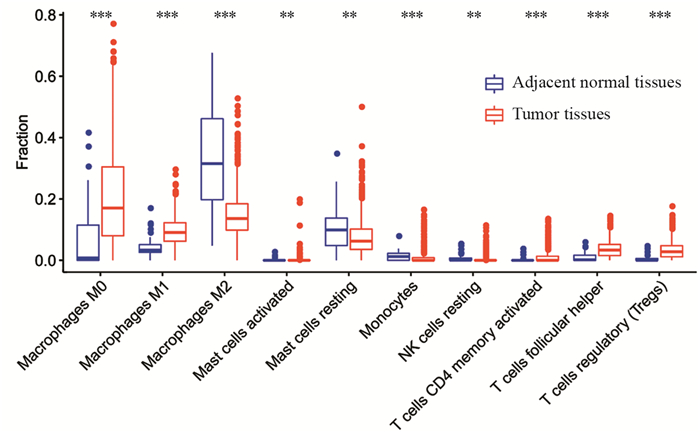
 下载:
下载:
